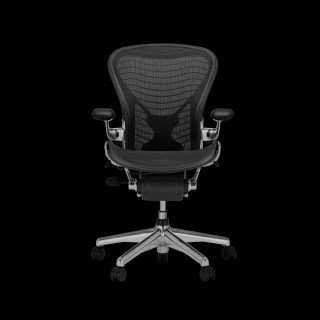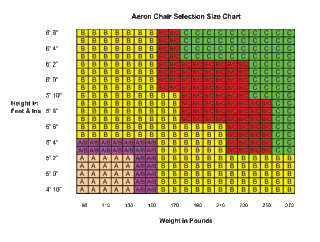- Manufacturer: Herman Miller
- Designer: Don Chadwick & Bill Stumpf
- Material: reinforced polyethelene terephthalate
- Dimensions: 107 × 69 × 69 cm
- www.hermanmiller.com

Index
- Materials The Aeron Chair has no padding. It is covered in a unique type of material called 'Pellicle'. This material distributes the weight of the person evenl
- Mechanism Kinesis is the Greek word for motion. The Kinemat tilt is a unique, highly sophisticated tilt mechanism patented by HM. It allows the body to pivot si
- Design When Don Chadwick and Bill Stumpf were asked to design a totally new type of office chair they set themselves the following design criteria: It should
- Designers Don Chadwick studied industrial design at the University of California Los Angeles until 1959. From 1964 he had his own design practice. Don Chadwick
- Origins While from today's perspective the design of the Aeron does appear like a scoop, the actual product history is one of evolution, predecessors and desi
- Size Most office chair manufacturers set out to make office seats that fit 95% of the population. However, most of the data used in anthropometric studies
- History The office chair was created to increase productivity and comfort while tasking for long hours. Office seating was first introduced with two functions
- Posture Poor posture at work is a major cause of back pain, workplace stress, repetitive strain injury, resulting in lost time, reduced productivity, poor emp
The Aeron Chair has no padding. It is covered in a unique type of material called 'Pellicle'. This material distributes the weight of the person evenly over the seat and back. It flexes to each person's unique shape. Pellicle fits the contours of the human body.
Hytrel
Pellicle means breathable or permeable membrane. It's a unique material developed and patented by Herman Miller. It's made of a synthetic material called 'Hytrel', woven in a straight and consistent pattern. It looks similar to net or wicker materials, but is much stronger.
A central issue in the development of the pellicle was aeration, or breathability. Air flow through the pellicle transfers moisture away, keeping the user's skin at a more comfortable temperature than foam/fabric seating. (Think of the beaded seat backs that taxi drivers use to stay cool).
Abrasion
The mesh has been branded as Pellicle (meaning a thin skin or membrane), clearly highly durable and resistant to wear (Herman Miller are so confident, they guarantee the mesh for five years). However, Newton's Third Law is spot-on here. The mesh has a curious effect on suit trousers and corduroy (we have dress down Fridays / yes I am aware that I am completely non-street wearing cords); the mesh 'shines' them and because downward pressure is being applied with some lateral movement a 'shaving' effect appears to take place. In short, wear jeans, overalls or sit au naturel. Or alternatively send Herman Miller the receipt for your replacement trousers, you never know.
Cradle to Cradle
All Aeron chair production will be Cradle to Cradle Silver certified effective February 16, 2009, and is already 94% recyclable and comprised of up to 64-percent recycled materials. The seat frame and back contain over 60-percent recycled content, made from approximately 36 recycled two-litre plastic beverage bottles per chair. Aeron is also assembled with 100% renewable energy and is 'Greenguard' certified.
Durability
Recycling isn't necessarily going to solve environmental problems. Durability may be more important. Aeron is expected to last longer than most chairs, so there's less need to replace and therefore less material refuse. The chair is also as lean as possible in use of materials. It uses the best materials from an environmental point of view - including recycled aluminium and polymers. Around 80% of the chair is further recyclable. Only one material is used for each component, or it's made certain that two or more materials are easy to separate. For recycling purposes, parts are clearly designated (metallic vs non-metallic), so they are easily identified when scrapping. And it consumes less energy during manufacturing than conventional foam-and-fabric seating.
Kinesis is the Greek word for motion. The Kinemat tilt is a unique, highly sophisticated tilt mechanism patented by HM. It allows the body to pivot simultaneously at the ankles, knees and hips, mimicking the natural motion of the human body, and giving a smooth ride. The backrest and seat pan move in proper relation for correct lumbar support in all postures from intense work to formal meetings to relaxed conversations. (The Kinemat tilt is different from a knee tilt, where the body rotates round a pivot point near the knee.)
When Don Chadwick and Bill Stumpf were asked to design a totally new type of office chair they set themselves the following design criteria:
- It should move and adjust as simply and naturally as possible.
- It should continue to fully support the back of a user who sat in the chair longer than he or she should do without taking a break.
- It should support a person in any position he or she cares to sit in, at any task his or her office job requires.
- It should do more than just accommodate people of various sizes but should fit the contours of their bodies.
- It should be aesthetically gentle on the eye, should not have a striking appearance and was not to be brightly colored.
- It should be durable, repairable, designed for disassembly and recycling.
The design of the Aeron chair did more than just fulfill the design criteria. It did not look like or behave like any office chair ever designed before.
Chadwick and Stumpf designed one chair, available in three sizes to fit everybody from the 1st-percentile (female) to the 99th-percentile (male). The B size chair is designed for the largest group of people on a Gaussian Chart, the 50th-percentile or the mean. The A-size chair, which adjusts lower than the other two are designed for smaller people and the C-size chair with the larger size seat and backrest is designed for larger people.
The majority of the Aeron Chair is made of recycled materials and is designed to last a long time. The parts that get the most wear are easily replaced and recycled.
The designers deliberately tried to make their chair look different than any other type of office chair on the market. If you examine the chair you will notice that it contains no straight lines. The designers have pointed out that the human form has no straight lines it is biomorphic. Their intentions were to create a chair that was also totally biomorphic.
Don Chadwick studied industrial design at the University of California Los Angeles until 1959. From 1964 he had his own design practice. Don Chadwick began to collaborate with Herman Miller, a furniture-making company, in the mid-1970s. At that time Bill Stumpf was assistant director of the research division. The collaboration between Don Chadwick and Bill Stumpf worked especially well for the development of office chairs.
The American furniture designer Bill Stumpf was born in St. Louis, Missouri, in 1936. He studied industrial design at the University of Illinois industrial design, followed up until 1968 by environmental design at the University of Wisconsin. From 1970 until 1974 Bill Stumpf was assistant manager of the research division at the Herman Miller Company.
Bill Stumpf: 'Everything goes back to those days at the University of Wisconsin,' he said recently, referring to the postgraduate years he spent studying and teaching at the university's Environmental Design Center. 'Everything was about freeing up the body, designing away constraints.'
While from today's perspective the design of the Aeron does appear like a scoop, the actual product history is one of evolution, predecessors and design optimizations. Since the 1970s, office furniture manufacturer and supplier Herman Miller was doing research in the field of office ergonomics and work seating. Building on a history of ties within the industrial design scene throughout the 1950s, 60s and 70s, HM hired Don Chadwick and Bill Stumpf in the 70s to rethink traditional designs. Their first product was the 'Ergon', a still traditional looking office chair but with clever tweak on the seat that supported and corrected the hip, pelvis and spine position - a twist that many of today's office chairs have adopted. The Ergon is still available today as the Ergon 3.
That was 1970-1976. Bill Stumpf first was assistant manager of HM's research division from 1970 to 1974. After that Stumpf formed a practice in Winona, Minnesota. In 1977, Don Chadwick, who previously was freelancer for HM, joined the outfit which became Chadwick, Stumpf & Associates and gave their successful past collaborations a corporate blanket.
Back to work, the next evolution in the process of refining the results was a chair titled the 'Equa' presented in 1984. In its essence the Equa combined the ergonomics of the Ergon with a new back that was mounted on a flexible dual-beam construction. When you look at the current reincarnation of the Equa, the Equa 2, the similarities between this earlier model and the Aeron become obvious. A bit of interesting trivia is that the Equa was also available with a rocking chair base that made a forward tilt possible which is common for computer or desk based tasks and working positions.
Finally, in 1994, Herman Miller presented the Aeron chair, a radical redesign of the Ergon and Equa principles. Equipped with the breathable (and officially trademarked) polyester fabric Pellicle©, adjustable lumbal support (Lumbar©), natural tilt kinematics and the option to choose between 3 sizes to fit the users body size, the chair further complies with ergonomic, functional, anthropometric and to top it all ecological standards. A reasonable employer just had no other chance than buying this office workhorse to perfectly nurture workers.
Most office chair manufacturers set out to make office seats that fit 95% of the population. However, most of the data used in anthropometric studies (the science of calculating body measurement) is to some degree, flawed.
The reason for this is that most of the studies come from military sources, which tend to have fewer very small and very large people and are therefore somewhat atypical.
Also, not enough attention has been given to the relationship of varying parts of the body's frame. […] Consequently, Herman Miller believe that office seats that purport to fit 95% of the population, may in reality mean that only 75% of office chair users are comfortably seated and this may even be as low as 60%, no one knows for sure. […] As a result of this information and their own unpublished survey results Herman Miller offer the Aeron ergonomic office chair in three sizes in an effort to address these issues and cater for the widest possible range of office chair users.

Case Study
- In 1998, a study was conducted by Coleman to determine the preferred lumbar support settings on adjustable office chairs (Coleman et al 1998.) The most significant finding of this study was the report from the author that nearly 1 out of 9 workers or approximately 11% of this population fell outside of the current BIFMA criteria of a standard office chair which is listed in the ANSI/BIFMA 5.1-2002 Guideline as 225lbs.
- In automotive and wheelchair seat design, tests are conducted with actual human like test dummies. They have begun to call for augmentation of the 100kg ISO test dummy with higher mass. Specifically, Cooper et al suggested that testing actually needs to occur up to 250kg with the greatest need being an immediate switch to testing with a 150kg dummy (Cooper et al 1999.)
Standards
Established in 1973, the Business and Institutional Furniture Manufacturers Association (BIFMA) International is a not-for-profit trade association of furniture manufacturers and suppliers addressing issues of common concern. The association serves as the industry voice for workplace solutions by providing standards development, statistical data generation, government relations, industry promotion, and education.
The office chair was created to increase productivity and comfort while tasking for long hours. Office seating was first introduced with two functions that set it apart from most other chairs. Office chairs had casters and a swivel function. These functions made employees much more mobile. The casters allowed for effortless rolling around a workstation or desk area. The swivel ability made it possible for one employee to perform multiple tasks at the same time because of the added range and movement.
The rapid development in our technology has created a huge demand for a number of different office chair designs. New technology creates new occupations and some of those occupations require new types of furniture. Much of the technological growth has come in administrative and information based fields. These fields have created the demand for specialized office seating like computer chairs and ergonomic office chairs. Other factors like climate and architectural design have recently influenced the office chair industry. The increased popularity of mesh office chairs in hot and humid climates is due in large part to the ability that mesh has to breathe and keep the user cool during the work day. On the other hand, chairs like the Aeron have been developed with a strong emphasis on modern, artistic design which has drawn the attention of any business trying to keep up with modern trends. There is also a big distinction in the style of chair that an executive uses compared to that of a typical employee.
Poor posture at work is a major cause of back pain, workplace stress, repetitive strain injury, resulting in lost time, reduced productivity, poor employee health, low morale, and higher costs.
Overworking
Health-positive ergonomic design anticipates and compensates for human error. When it comes to using an office chair, the most common error is simply using it for too long. Made for movement, the human body suffers in the static postures associated with mental work. To compensate for worst-case situations that keep a person seated at a keyboard for more than two hours at a stretch, the Aeron chair's designers built in health-positive features that help to keep the body healthy and comfortable in work-intensive postures.
Work days lost due in the UK (2007-2008) due to musculoskeletal disorders
0.37 Average days per worker
16.4 Average days lost per case
Total = 8,845
































































































